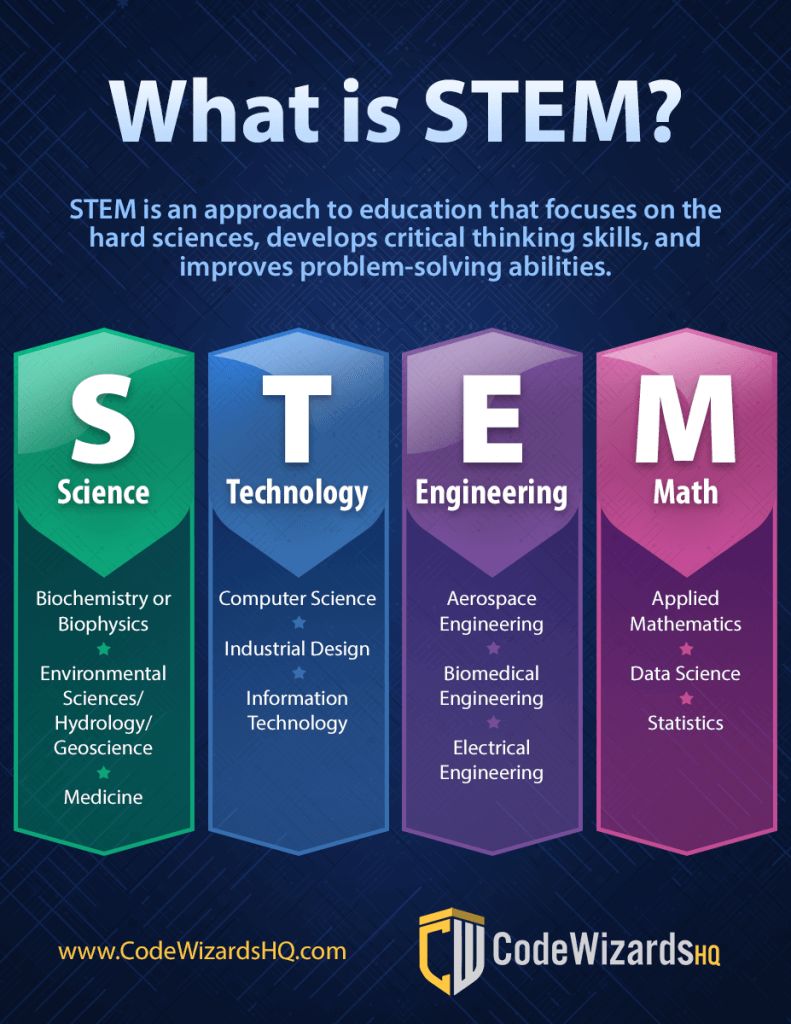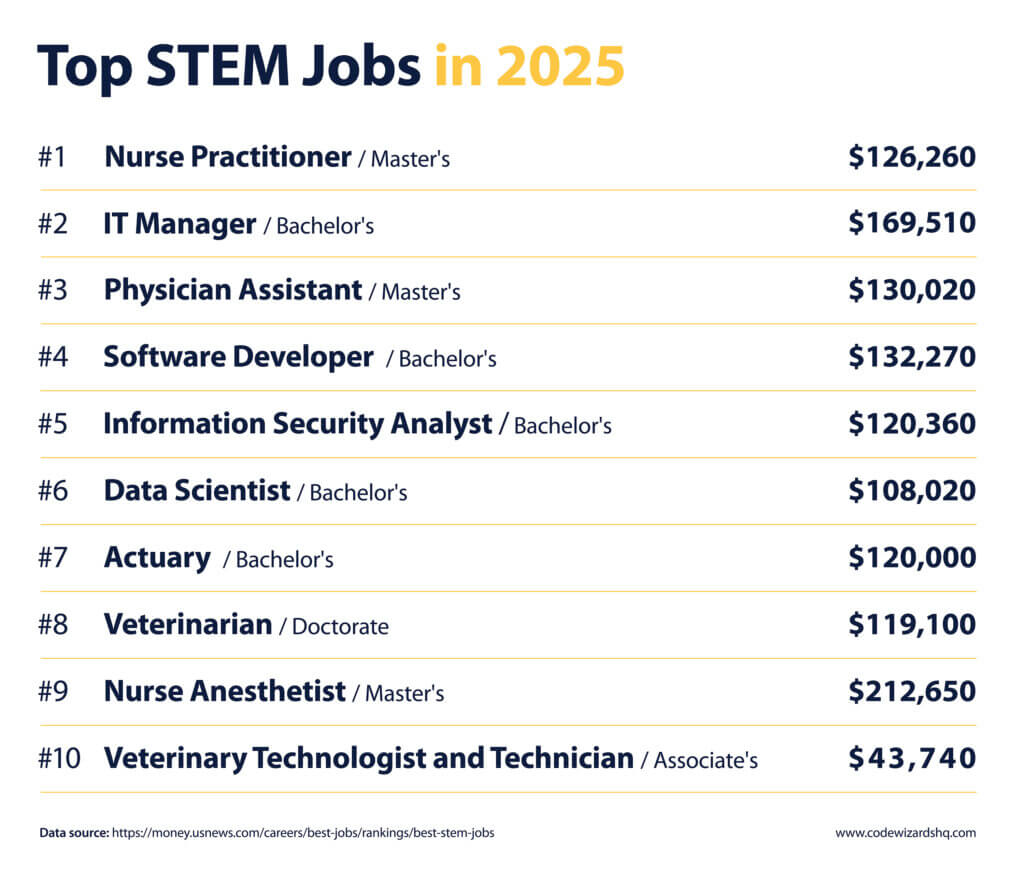New technologies and jobs are being created at a blistering pace all around us. Many of these cutting-edge technologies and jobs are related to a group of studies known as STEM. So, what does STEM stand for, and what’s its importance for your child?
STEM education is all about preparing kids for a digital future and understanding the new world around them. Therefore, STEM fields are imperative for 21st-century career readiness and global competitiveness.
- What does STEM stand for?
- What is STEM?
- What Are The Benefits Of STEM?
- What Are STEM Skills?
- How Can I Improve My STEM Skills?
- Examples Of STEM Careers.
- Is Coding a Part of STEM?
- Is STEM Good For Kids?
- Why Is STEM So Important In Early Childhood Education?
- How Do I Get My Child Into STEM?
- CodeWizardsHQ Classes Can Get Kids Started In STEM From Home.
What does STEM stand for?
STEM stands for Science, Technology, Engineering, and Math.
S – Science
T – Technology
E – Engineering
M – Math
It is an acronym coined in 2001 by the U.S. National Science Foundation (NSF).
What is STEM? STEM Meaning and Definition
STEM (Science, Engineering, Technology, and Mathematics) is an approach to education that focuses on the hard sciences, develops critical thinking skills, and improves problem-solving abilities.
Education in STEM aims to give students the tools they’ll need to succeed in school, work, and hobbies. It’s like a toolbox full of smaller toolsets for designing and making things. Inside a carpenter’s toolbox, you might find sets of drill bits, ratchets and wrenches, chisels, and other useful gadgets. Similarly, STEM disciplines are like those little toolsets. Each is useful in its own right, but most activities require more than one.
Coding can apply across all STEM disciplines. It is part of the technology category, but science, engineering, and math also utilize code and programming.

Recommended: STEM Classes for Kids
What are the benefits of STEM education?
STEM education equips kids with competencies that will enable them to overcome personal challenges, pursue a college education or career in technical fields such as software engineering or artificial intelligence, find creative solutions to difficult problems, and understand how the world works. For example, perseverance is important to success in almost any endeavor.
STEM helps kids learn to stick with difficult tasks and abstract ideas. Math is hard. Coding is too. In fact, professionals in STEM fields often enjoy complex problems. Likewise, kids who push through the frustrations learn that great rewards lie on the other side of big challenges. John F. Kennedy articulated the attitude of STEM professionals in 1962 when he said, “We choose to go to the moon in this decade and do the other things, not because they are easy, but because they are hard.”
Kids who believe in themselves tend to do better in school. Writing code and seeing it work is satisfying. Building a robot, programming it to execute a task, and watching it happen is thrilling. But while kids are having fun, they’re also building confidence. That confidence is important in test-taking and academic achievement.
Throughout the STEM curriculum, students have opportunities to use and get comfortable with technology. Computers, peripherals, sensors, and other instruments are important tools in many STEM classrooms and education programs.
There are many benefits to empowering kids with STEM, yet it appears the US is falling behind in STEM education.
Recommended: Why Your Kids Should Learn Coding
What are STEM skills?
Skills gained from STEM education include:
- Complex Problem-solving
- Critical thinking
- Reasoning
- Creativity
- Teamwork
- Self-confidence
Science is a body of knowledge and a method of inquiry. It’s about asking the right questions and finding accurate answers. The basic sciences taught in class prepare STEM students to explore biology, chemistry, and physics. Often, collaborative projects are involved, so kids need to be able to work together. Science classes introduce the thrill of experimentation and discovery to individual students as well as teams. And because modern-day scientists use computers and technology in much of their work, science classes frequently incorporate these tools.
Technology is used in various forms to turn ideas into real things. 3D printers, CNC machines, robotics, and the Internet of Things (IoT) are just a few of the tools that enable creators to transform imagination into reality. Coding is also an important technology discipline. For that reason, kids in STEM learn about these tools and how to use them.
Engineering is about designing, testing, and building. These skills are part of the STEM curriculum and sometimes require software or other tools. Kids may learn to use CAD/CAM software to design a part, analyze its physical properties, and generate the code required to actually make it on a 3D printer or CNC machine.
Math skills for STEM include everything from basic arithmetic to calculus. Students may need to do some manual calculations, but they should also know how to use powerful tools like Python’s built-in math libraries. Probability, graphing, linear algebra, and other tasks are fast and accurate with the right tools. Students in STEM may learn about these tools much earlier than their peers.
Recommended: Free Coding for Kids Resources

How can I improve my STEM skills?
There are many educational and fun ways to improve problem-solving, math, and coding skills.
- STEM kits
- Online STEM classes
- STEM clubs and competitions
STEM kits let kids explore electronics, robotics, and programming. Arduino, SparkFun, and other companies make small, programmable computers that can hook up to sensors, motors, lights, speakers, and other gadgets. Online STEM classes are also a convenient and affordable way to explore a variety of STEM subjects. Clubs and competitions can build teamwork and STEM skills. In addition, books are a great resource for kids who like to read.
Some online and in-person classes combine multiple STEM fields, such as computer science, programming, and math. Multi-disciplinary, project-based courses can make learning fun. Live, instructor-led coding courses like those from CodeWizardsHQ give kids personal attention that can keep them in sync with their peers.
Popular STEM careers
Top STEM jobs in 2024
Lucrative and popular STEM careers exist in many seemingly disparate fields, such as computer programming, medicine, and statistics. Additionally, jobs in these areas tend to pay quite well. According to U.S. News and World Report’s ranking of the 30 best STEM careers in 2024, eight of the top 10 STEM jobs come with annual salaries above $100,000. The number two position on the list is Software Developer, with an average yearly income of $127,260. The list ranks jobs based on salary, unemployment rate, growth, and other factors. Here are the 10 best STEM jobs:
Types of STEM Careers
Careers in the hard sciences, like biology, chemistry, neuroscience, and physics, are ideal for many STEM students. Mechanical engineering, chemical engineering, electrical engineering, architecture, and industrial design are excellent for people who enjoy designing and building things. Computer science and programming are also popular fields for those who appreciate logic and creative problem-solving.
According to the U.S. Census Bureau in 2021, majoring in STEM may pay off even for those who end up working in non-STEM fields. Among the 50 million employed college graduates ages 25 to 64 in 2019, 37% reported a bachelor’s degree in science or engineering but only 14% worked in a STEM occupation. STEM workers who majored in a STEM field in college typically made higher salaries than those who did not: on average, $101,100 vs. $87,600.
STEM skills can be useful in other careers too, like technical writing.
A technical writer plans and writes instruction manuals for scientific instruments, lab equipment, machinery, software, and just about any kind of product. In order to produce helpful instructions, the writer needs to understand how the product works and has to be able to communicate that information in simple terms. Manufacturers, government agencies, software publishers, and social media companies employ technical writers to communicate with their users.
Many trade jobs require a high degree of computer literacy and some familiarity with programming. For example, in the woodworking industry, CNC machines cut, route, and drill the parts that become cabinets and furniture. A skilled woodworker programs and troubleshoots those machines. Success in the woodworking trade now depends, in part, on computer skills. A basic knowledge of programming concepts is also beneficial, and will probably be even more so as automation increases.
STEM is even helpful for some sales professionals.
Imagine being a sales representative for a company that manufactures environmental monitoring instruments. Your prospective clients might be scientists or engineers. As a result, they’ll expect you to understand enough about what they do to provide them with equipment that meets their needs. That could mean having a solid grasp of basic chemistry, data science, or some other technical subject.

Recommended: STEM Education Statistics
Is coding a part of STEM?
Coding for kids is one of those skills that can be applied broadly across many different disciplines. While coding is often compared to learning a language, the skills learned in coding are actually more closely related to the STEM subjects.
For instance, the process of debugging code aligns nicely with the scientific method. Coders and scientists both test their hypotheses through experimentation. They observe the results and adjust based on what they see. Math concepts can easily be seen in coding. Things like measuring distances and working with variables are foundational. And many of our technologies and engineering jobs are dependent upon a firm foundation of code. When we look at the concepts that make up STEM, coding is linked with each of them.
Taking a coding class is a great way to get introduced to STEM education.
Recommended: 25 Fun STEM Activities for Kids
Is STEM good for kids?
Some of the most prominent figures in business and technology started tinkering with STEM subjects as kids. When he was just 12 years old, Elon Musk was already so adept at coding that he was able to build and sell his first computer game. At the same age, Facebook founder Mark Zuckerberg created messaging software that enabled the staff in his dad’s dental office to communicate from different parts of the building. Zuckerberg had a private tutor. Musk loved to read. But both were interested in STEM when they were quite young.
STEM education has myriad benefits for young people. For instance, it introduces them to exciting subjects that can lead to lucrative and fulfilling career opportunities. For girls especially, early exposure to computer science appears to make them more likely to major and work in the field. With companies like Google making efforts to achieve gender parity, opportunities for girls in tech are expanding.
Kids who study STEM can build the foundation required to pursue degrees in high-paying fields like computer science. Graduates with degrees in this field earn more over their lifetimes than graduates with other degrees.
Why is STEM so important in early childhood education?
Getting into STEM early can be the key to a lifelong interest and a productive career in related disciplines, especially for girls. Women currently represent a smaller percentage of people with a STEM career than men. Women remain underrepresented in engineering (15%), computer (25%) and physical science (45%) occupations (U.S. Census Bureau). But some organizations are trying to change that, and they need qualified candidates with STEM backgrounds to do it.
STEM teaches kids the skills they need to do well in school, and not just in their STEM classes. For example, critical thinking is valuable in reading, writing, and other subjects too. STEM also gets students interested in constructive hobbies. Many people working in computer science and engineering started out by experimenting with computer programming, ham radio, or electronics as kids.

How do I get my child into STEM?
The earlier your child can get into STEM education, the better. There are afterschool coding programs for in elementary school, middle school, and high school. Online education is an easy and convenient way to get started. Good programs make learning fun and help kids build skills that apply broadly. For example, CodeWizardsHQ coding classes for elementary students start with the fundamentals of the Scratch programming language. Scratch is a visual language that involves dragging little blocks of code around the screen and connecting them, but the concepts it uses apply to all languages.
Resources for getting kids into STEM
Opportunities for kids to get into STEM are numerous and span the technological spectrum. The following list includes digital and non-digital ways to get started.
Kids Ages 5 and Under
-
- Let’s Go Code is an activity set that teaches programming fundamentals with fun games. Everything in this set happens away from the computer, so it’s fun for younger kids.
-
- DragonBox Algebra is a mobile game designed to teach algebra to kids as young as five. It may seem impossible for kids that young to learn something so complex as algebra, but Dragonbox makes it fun and easy.
-
- Baby Loves Science is a collection of four books about STEM written specifically for young children.
Kids Ages 6-10
-
- STEM Machines makes kits that let kids explore physics, engineering, and other topics by assembling little machines. There are several different kits and each covers a different topic.
-
- Lego Chain Reactions is a small set of Lego building blocks and a book with instructions for several cool Lego machines. Kids will need to have some Legos already, but the kit includes all of the special blocks necessary.
-
- For some students, the language of math can be confusing. This is certainly true once kids get into algebra. For example terms like such that, simplify, and evaluate aren’t always intuitive to children. My First 100 Mathematics Words introduces math vocabulary in just 24 pages of colorful drawings.
Kids Ages 11-13
-
- Dragonbox Algebra 12+ is the sequel to the Dragonbox 5+ mobile game mentioned above. It teaches more complex algebra using the same techniques and play style as the first game.
-
- CarnegieSTEMGirls.org is a website about STEM that’s tailored to girls. There are links to classes, books, and activities. The site also has information for parents.
-
- Adafruit sells a wide variety of electronics like motors, sensors, single board computers, and more. They also have lots of tutorials and helpful resources for anyone wanting to explore electronics.
Kids Ages 14-18
-
- Single-board computers from Arduino are excellent for teenagers who want to explore coding and robotics. The project opportunities are limitless, but the first step is to check out Arduino’s website and learning resources.
-
- YouTube is full of videos about STEM topics, but not all of the content is worth watching. However, I Like to Make Stuff is one channel every aspiring maker should see. Bob, the channel’s creator, films himself building various projects and always narrates the whole process of creating something.
-
- Krista King is another YouTuber, and her channel is one of the best resources for math students on the internet. Her videos range from middle school math topics to calculus, and she does a great job explaining complex topics in easy to understand terms.
Recommended: Coding Classes for Teens
CodeWizardsHQ classes can get kids started in STEM from home.
Online computer science classes provide easy access to STEM education and fun projects that keep kids excited about learning. CodeWizardsHQ students develop coding skills quickly with interesting challenges like building animations and games. Coding classes are 12 sessions long and delivered live by expert instructors. During class, students learn core programming concepts by building increasingly complex projects and progressing through the curriculum.
Elementary students master programming basic starting with simple games, moving through web development, and taking off into more difficult challenges. Middle school coding starts with classes in Python, a powerful language used for everything from web development to data science. Then, in high school coding classes, students dive into deep topics like algorithms, artificial intelligence, and machine learning.
Kids who get into STEM will be prepared for the challenges they’ll face throughout their schooling and later in life. Opportunities to get into science, technology, engineering, and math are abundant. There have never been so many interesting ways to get started. The key is to take that first step. Now is a great time to do it.

